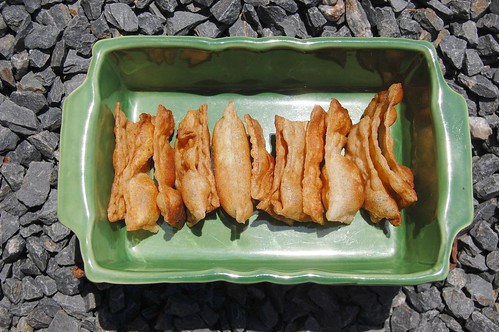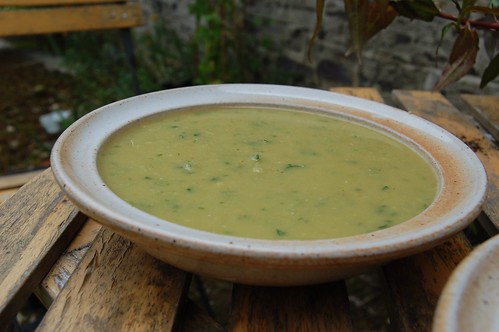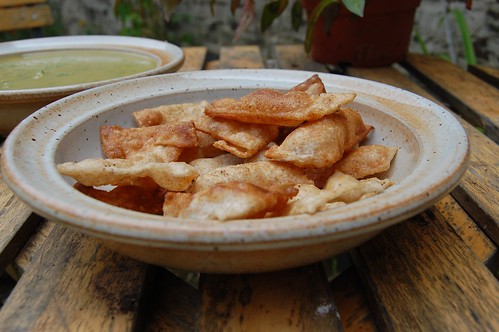Anyway, the first two dishes that seemed easy to bring back into the vegan repertoire are Etnos, a very simple dried pea soup that is still standard fare all over the globe and Lagana, which is fried pasta. This makes a sort of crisp puffy wafer, golden and with a snap to it. It seems the Italians didn't hit on the idea of boiling their pasta until the middle ages.
 This very simple fried bread was used to scoop up the soup as a sort of edible spoon. I am actually thrilled at how easy and effective this was, as my experience of frying flour and water pastes in the past has been mixed to say the least.
This very simple fried bread was used to scoop up the soup as a sort of edible spoon. I am actually thrilled at how easy and effective this was, as my experience of frying flour and water pastes in the past has been mixed to say the least. 
To make stacks of lagana (at least 100) you need:
150g flour. I think the type of flour is probably important. I used a medium atta, a wholemeal chapatti flour, sieved before weighing to remove the coarsest portions of the bran.
90-100ml water. Start with the lower amount and add a little extra if needed.
Oil, preferably olive, for cooking.
Mix the flour and water together to form a smooth pliable dough. Knead it for a minute or two. I wondered if it would need a rest period and tried cooking some immediately and then after a rest of a couple of hours but it seemed to make no difference.
Seasoning, there is none but I think some crushed pepper would sit nicely in this.
Roll small portions, the ubiquitous walnut sized lump springs to mind, out on a lightly floured board as thinly as you can, and I mean thinly but I didn't measure it, so I can't tell you exactly. Not quite as thin as phyllo pastry but getting there. After trimming the edges I got ten chips out of each of my walnut sized lumps.
I cut my sheets of rolled dough into rectangles about 2cm by 4cm which makes a good size for a couple of bites. The frying and rolling is probably best approached on a production line basis if you have help. I had to stop and take my pan off the heat a couple of times to roll out more crackers. The crisps cook so quickly that a constant feed stream is practical.
Heat about 1cm of oil in a heavy flat bottomed pan. The temperature needs to be just hot enough and shouldn't be smoking. Try a test piece, it should sizzle around the edges if the oil is hot enough. I used a frying pan but you could probably do this in a deep fryer if you wanted. Float each cut section on the oil. It will immediately puff up, sometimes in little bubbles but sometimes as perfect jolly little pillows. Turn them over almost immediately and allow the second side to cook, then remove from the oil and allow to drain on a rack or kitchen towel.
Like many fried goods these benefit from a few minutes in a warm oven to remove the greasiness so it's possible to cook quite a lot and keep them warm while you finish the batch.

The soup is simply a couple of handfuls of split green peas, soaked over night and then cooked with a chopped leek or onion for an hour or so at a simmer until the pulses are completely soft. Whizz them up with a stick blender (or get the house slave to rub them through a sieve) and then season with herbs, salt and pepper. The Romans liked dill in their pea soups but mint or coriander are acceptable substitutes. A drizzle of olive oil is also used for flavour but I left it out of mine because of all the fried noodles to come.
The soup needs to be thick. If there's still a lot of water in the pan when the peas are cooked strain some off before blending or you'll have to do what I did and simmer the soup again to make it thicker.
The simple flavours and bland texture of the soup are an excellent match for the puffy, crispy lagana which worked really well as spoons. They are particularly good when they've formed pillows as you can use them to scoop up the soup inside them for a taste explosion when they get to the mouth. It's all pretty easy too. I'll be trying more recipes from this book over the summer.

1 comment:
Love it. Historical food is so much fun. Plus, sounds tasty... I'll definitely try them.
Do you know Four Pounds Flour? It's a wonderful historical food blog. Look for the recent article about an 8,000 year old recipe...
Post a Comment